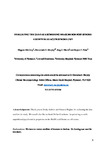Evaluating the GAD-2 to screen for post-stroke anxiety on an acute stroke unit
| dc.contributor.author | McCrory, M | |
| dc.contributor.author | Murphy, DF | |
| dc.contributor.author | Morris, R | |
| dc.contributor.author | Noad, RF | |
| dc.date.accessioned | 2022-08-17T09:56:27Z | |
| dc.date.issued | 2022-02-12 | |
| dc.identifier.issn | 0960-2011 | |
| dc.identifier.issn | 1464-0694 | |
| dc.identifier.uri | http://hdl.handle.net/10026.1/19542 | |
| dc.description.abstract |
Post stroke anxiety is associated with reduced quality of life, worse rehabilitation outcomes and poor social functioning in stroke survivors. Despite its clinical relevance, there are a lack of screening tools to identify post-stroke anxiety. The Hospital Anxiety and Depression Scale (HADS-A) and Geriatric Anxiety Inventory (GAI) are the only self-report screening test for anxiety validated in stroke patients. However, both of these measures have limitations associated with their clinical utility, length of time to administer and cost to purchase. This study aimed to assess the classiciation accuracy of a freely available and shorter alternative, the Generalized Anxiety Disorder 2-item (GAD-2) for use in the acute stroke setting. This study used retrospective analysis of a sequential sample in a clinical database of mood and cognitive scores. Patients' scores on the GAD-2 and HADS-A were compared. The GAD-2 demonstrated strong convergent validity with the HADS-A and good specificity and sensitivity for clinical anxiety. In conclusion, the GAD-2 may be a useful screening assessment of post-stroke anxiety in the acute setting; however, it should be used with due consideration of the methodological limitations of this study. | |
| dc.format.extent | 1-17 | |
| dc.format.medium | Print-Electronic | |
| dc.language | en | |
| dc.language.iso | en | |
| dc.publisher | Informa UK Limited | |
| dc.subject | Stroke | |
| dc.subject | Screening | |
| dc.subject | Anxiety | |
| dc.subject | Validation | |
| dc.subject | GAD-2 | |
| dc.title | Evaluating the GAD-2 to screen for post-stroke anxiety on an acute stroke unit | |
| dc.type | journal-article | |
| dc.type | Journal Article | |
| plymouth.author-url | https://www.webofscience.com/api/gateway?GWVersion=2&SrcApp=PARTNER_APP&SrcAuth=LinksAMR&KeyUT=WOS:000754443100001&DestLinkType=FullRecord&DestApp=ALL_WOS&UsrCustomerID=11bb513d99f797142bcfeffcc58ea008 | |
| plymouth.issue | 3 | |
| plymouth.volume | 33 | |
| plymouth.publication-status | Published | |
| plymouth.journal | Neuropsychological Rehabilitation | |
| dc.identifier.doi | 10.1080/09602011.2022.2030366 | |
| plymouth.organisational-group | /Plymouth | |
| plymouth.organisational-group | /Plymouth/Faculty of Health | |
| plymouth.organisational-group | /Plymouth/Faculty of Health/School of Psychology | |
| plymouth.organisational-group | /Plymouth/REF 2021 Researchers by UoA | |
| plymouth.organisational-group | /Plymouth/REF 2021 Researchers by UoA/UoA04 Psychology, Psychiatry and Neuroscience | |
| plymouth.organisational-group | /Plymouth/REF 2021 Researchers by UoA/UoA04 Psychology, Psychiatry and Neuroscience/UoA04 Psychology, Psychiatry and Neuroscience MANUAL | |
| plymouth.organisational-group | /Plymouth/Users by role | |
| plymouth.organisational-group | /Plymouth/Users by role/Academics | |
| dc.publisher.place | England | |
| dcterms.dateAccepted | 2022-01-11 | |
| dc.rights.embargodate | 2023-2-12 | |
| dc.identifier.eissn | 1464-0694 | |
| dc.rights.embargoperiod | Not known | |
| rioxxterms.versionofrecord | 10.1080/09602011.2022.2030366 | |
| rioxxterms.licenseref.uri | http://www.rioxx.net/licenses/all-rights-reserved | |
| rioxxterms.licenseref.startdate | 2022-02-12 | |
| rioxxterms.type | Journal Article/Review |


